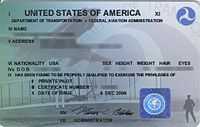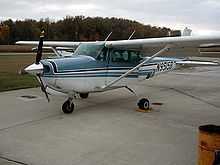Private pilot licence

A private pilot licence (PPL) or, in the United States, a private pilot certificate, is a license that permits the holder to act as the pilot-in-command of an aircraft privately (not for pay). The requirements to obtain the license are determined by the International Civil Aviation Authority (ICAO), but the actual implementation varies widely from country to country. According to the ICAO, it is obtained by successfully completing a course with at least 40 hours (45 in Europe) of flight time, passing seven written exams, completing an extensive solo cross country flight (minimum cumulative solo flight time is 10 hours), and successfully demonstrating flying skills to an examiner during a flight test or checkride (including an oral exam). In the USA, pilots can be trained under Title 14 of federal code part 141 which allows them to apply for their certificate in as little as 35 hours.[1] However, most pilots require 60–70 hours of flight time to complete training.[2] The minimum age for a private pilot certificate is 16 for balloons and gliders, and 17 for powered flight (airplanes, helicopters, and gyroplanes). Pilots can begin training at any age and can solo balloons and gliders at age 14, powered aircraft at age 16.[3]
Issuing authorities
A PPL may be issued by the FAA for US certification, the JAA / EASA for European certification, the CASA for Australian certification, or Transport Canada for Canadian certification. Each organization has different requirements.
Categories and classes

Different types of private licenses are issued for the major categories of aircraft. It is possible to obtain a license for, e.g., rotorcraft or airships, without first — or ever — obtaining a license for a fixed-wing aircraft. However, limitations, such as "limited to hot air balloons with airborne heater" for hot air balloon ratings (as opposed to a gas balloon) will appear on the license under the "Limitations" portion of the certificate. The classes listed on the license further define which aircraft of a given category the license holder is qualified to operate.
With respect to the certification of airmen, the structure of aircraft categories and further subdivision into classes are as follows:[4][5][6]
- Airplane
- Single-engine land
- Single-engine sea
- Multiengine land
- Multiengine sea
- Rotorcraft
- Helicopter
- Gyroplane
- Glider
- Lighter-than-air
- Airship
- Balloon
- Powered-lift
- Powered parachute
- Powered parachute land
- Powered parachute sea
- Weight-shift-control
- Weight-shift-control land
- Weight-shift-control sea
Ratings
A license will contain a number of sub-qualifications or ratings. These specify in more detail the actual privileges of the license, including the types of aircraft that can be flown, whether flight under instrument flight rules and at night is allowed, and whether instructing and examining of trainee pilots is authorized. Ratings include Single and/or Multi-Engine Aircraft, Land or Seaplane, each of which require a checkride with an approved examiner.
Additional endorsements
In addition, a number of endorsements are available for specific skills (additional requirements apply). Endorsements only require instruction and a Flight Instructor's endorsement, they do not require any flight test with an FAA representative and are placed in the pilot's logbook, not on the license itself.
Sec. 61.31 Federal Aviation Regulations endorsements required to act as pilot-in-command (PIC) are:
- Tailwheel
- Complex airplane – aircraft with a variable-pitch propeller, flaps, and retractable landing gear
- High-performance (more than 200 horsepower per engine)
- Pressurized aircraft capable of operating at high altitudes
Other aircraft operations for which the FAA does not require an endorsement that typically require additional training are glider towing and aerobatics. The FAA also does not require an endorsement for some commercial activities like banner towing or aerial application (crop dusting).
See also
- Commercial pilot license
- Pilot licensing and certification
- Pilot licensing in Canada
- Pilot certification in the United States
- Private aviation
References
- ↑ 14 CFR FAR Part 61.109(k)(2)
- ↑ AOPA FAQ
- ↑ FAA – aviation medical examiner
- ↑ "Pilot Practical Test Standards". FAA. Retrieved 2013-01-08.
- ↑ 14 C.F.R. 61.1
- ↑ 14 C.F.R. 61.107
External links
- FAA Registry: Airmen Certification Inquiry
- Private Pilot Practical Test Standards for Airplane (FAA, August 2002)
- Computer Testing Supplement for Recreational Pilot and Private Pilot (FAA, 2004)
| ||||||||||||||||||||||